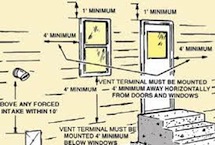Combustion Inside the Living Space
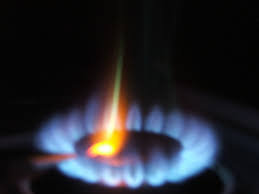
Combustion appliances are those that burn fossil fuels, wood or other biomass. Inside the living space is the main place we breathe air.
Eliminate the combustion appliance, eliminate the risk. We can use these common appliances in better ways, but if serious about indoor-air quality, look hard at any decision to include a combustion appliance inside the living space.
Combustion appliances include: fireplaces, woodstoves, gas cooktops, gas water heaters, gas heating (furnaces and boilers), and gas dryers.
  |
  |
 |
 |
| The worst thing to include inside a home? Terrible for indoor-air, expensive, high maintenance, risky, rarely used and unless well-sealed when not in use, an energy cost nightmare. Fire good, safer outside. | Gas cooktops are hard to clean, inefficient, and a major polluter of indoor-air. Most who try both, prefer induction cooktops to gas. Gas cooktops need to be well-vented to the outside with kitchen vent hoods of proper rates and capture efficiency of the hood area. | Do not choose or replace gas water heaters with natural drafts as noted by gap between vent and top of tank. Upgrade to direct-vented or be even smarter, finding a location for the heat pump water heater. | Most tankless water heaters are gas. While pretty safe, they still carry indoor-air risk among other problems. |
Burning wood inside? 
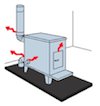 Fire is an obvious threat to account for. Venting combustion gases may carry as much risk with deleterious effects on indoor-air quality. At least wood stoves provide useful heat, a cheap fuel and make good backup heat sources if power outages are frequent. This all comes with serious indoor-air quality and outdoor-air quality concerns.
Fire is an obvious threat to account for. Venting combustion gases may carry as much risk with deleterious effects on indoor-air quality. At least wood stoves provide useful heat, a cheap fuel and make good backup heat sources if power outages are frequent. This all comes with serious indoor-air quality and outdoor-air quality concerns.
There are ways to reduce smoke but indoor-air will always suffer when relying on indoor wood burning for heat. No matter how good the stove, draft or burn, particle pollution from smoke and ash cleanout is always undesireable.
Exhaust-Only Vents Suck

Houses that suck, or are under negative pressure from exhaust-only vents can pull in dangerous pollution from garage, ground, hidden building cavities or other appliance vents with combustion exhaust being the greatest concern. Most homes need to vent clothes dryers, bath vents and kitchen cooktops. These exhaust-only vented appliances compete which reduce their exhaust efficiency. Even a single exhaust vent can put the building envelope under negative pressure.
For those unable to eliminate combustion for space and water heating, choose quality contractors and appliances featuring direct venting with dedicated supply ducts. Code requires dedicated make-up air for kitchen vent hoods with more than 400 CFM. Fireplaces and woodstoves are more contentious for make-up air provisions.
Even with wiser indoor combustion, there is risk of manufacturer defects, installation error, lack of maintenance and end-of-life concerns that come with bringing a controlled fire and its long-term exhaust considerations, inside the home.
Natural Forces That Suck
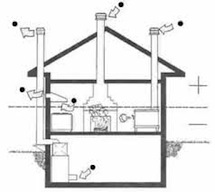

For designers considering fireplace locations, I recommend this hearth in the house as a system site. While strong exhaust-only vents deserve more attention, wind and pressure planes impact the effectiveness of all combustion appliances.
Tight homes exacerbate these problems. Exhaust vents have less air-leakage to help equalize pressures. Leaky homes offer no guarantee of venting success, only wasted energy and even more risks to IAQ.
Building systems eventually fail.



Gas is a poor choice of infrastructure
Water and electricity are required in most homes. Appliances that burn stuff are not. With the exception of woodstoves, there is a cost-effective replacement for every combustion appliance. For space and water heating, heat pump technology is cost competitive with gas for thermally efficient building envelopes.
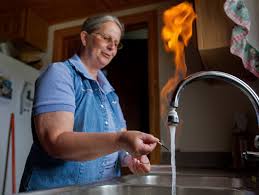
Energy use is #1 on our list of green building's top 3 priorities. We make the case that gas is not the best choice of infrastructure.
Gas infrastructure comes with another utility provider sending monthly service fees, despite the amount used. Gas supply lines, venting, and contractor charge per drop, should be included in the economics for any perceived energy savings. Renewables and building envelopes are a better investment.
Gas increases air leakage in risky areas
 For builders in pursuit of airtight construction, and better weather barriers that resist bulk water leaks, additional infrastructure of gas lines, supply-air and make-up air ducts must penetrate the building envelope. We are currently exploring a build containing seven extra gas related penetrations in the building envelope. Counting an air-barrier and redundant weather barrier, is 14 extra penetrations to be detailed, most of them adjacent to fossil fuel exhaust locations. Will the trades get it right? Will the homeowner maintain it?
For builders in pursuit of airtight construction, and better weather barriers that resist bulk water leaks, additional infrastructure of gas lines, supply-air and make-up air ducts must penetrate the building envelope. We are currently exploring a build containing seven extra gas related penetrations in the building envelope. Counting an air-barrier and redundant weather barrier, is 14 extra penetrations to be detailed, most of them adjacent to fossil fuel exhaust locations. Will the trades get it right? Will the homeowner maintain it?
Gas increases design problems presented by exhaust pollution
Technology and efficiency is making gas obsolete. Heating with wood is tougher to dismiss but the amount needed and pollution generated can be drastically reduced with thermally efficient building envelopes, heat pumps, PV solar and passive solar design. We are past the stone age and trying to pass the fossil fuel age.
We do include fireplaces and combustion appliances for clients and homeowners, but we encourage reducing or eliminating them when possible. Our previous post on common but unhealthy building practices, explores a code-compliant detail that we will not include.
 Vented-Crawlspaces Should Be Illegal.
Vented-Crawlspaces Should Be Illegal. .jpg) Dangers of Attached Garages
Dangers of Attached Garages  3 Forms of Solar Energy For Homes
3 Forms of Solar Energy For Homes
Springtime Builders is a custom builder in Asheville NC specializing in building science craftsmanship and better indoor-air quality.
Posted in Indoor Air Quality
